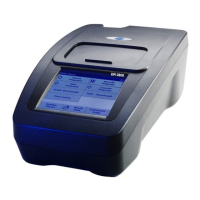34
Standard Operations
5.4.3 Using Program Timers
Some procedures do not require the use of timers. Other
procedures require several timers. These timers are
pre-programmed into each Stored Program, along with a
description of the activity to be performed during the timed period.
1. Press the
TIMER icon on the display.
2. Press
OK to start the first timer. The timer will count down on
the screen.
3. To start the next timed activity for the Stored Program, press
the
TIMER icon and OK. The Timer will beep at the end of the
running time.
Note: To view the Program screen while the timer is running, press CLOSE.
The time will be shown on the bottom-left instead of the date.
Note: If necessary, press
CANCEL to terminate the timer midway through
the countdown.
Dilution Factor Off/On
A corrective dilution factor can be entered in order to take account of certain properties.
The number entered at the dilution factor prompt will be multiplied by the result to compensate for
the adjustment. For example, if the sample has been diluted by a factor of 2, enter 2. The default
setting of the dilution factor is 1, corresponding to no dilution.
Note: When a dilution is in effect, the
DILUTION icon will appear on the display.
Standard Additions
Enables the accuracy of the measurements to be checked. The working procedure for a test
parameter contains a detailed explanation of how to use this function.
Standard Adjust
The working procedure for a test parameter indicates whether a standard adjustment is
necessary and, if so, how to proceed. Adjusts the pre-stored calibration for variations between
reagent lots or instrument variation.
Chemical Form
For some stored programs, an alternate chemical form and corresponding test range can be
selected.
Reagent Blank
Enables the reagent blank value to be added to, or subtracted from, the subsequent readings.
The reagent blank value shifts the calibration curve along the y-axis, without changing the shape
or gradient of the curve. The effect corresponds to a y-axis intercept of the calibration straight
line. This is made clear by the following equation: Concentration = [(Conc. factor) * Abs] –
(reagent blank value).
Save as User Program Stores the selected parameters as a User Program, see section 6.1 on page 47.
Recall Data
Recalls saved measurement data, wavelength scans, or time courses, see section 5.3 on
page 28.
Instrument Setup Basic operational settings of the instrument, see section 5.2 on page 23.
Table 3 Stored Program Options (continued)
Options Description

